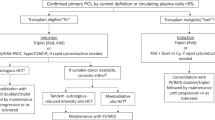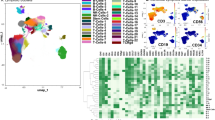Abstract
Myeloma patients failing to achieve a complete response post autologous stem cell transplantation are heterogeneous, some ultimately achieving deeper responses and prolonged remission, whilst others relapse rapidly with poor outcomes. We evaluated the prognostic impact of the plasma cell proliferative index (PCPI) post-therapy, in 382 patients with myeloma failing to achieve complete response at 100 days post-transplant. Sixty percent (n = 230) of patients had zero clonal or too few clonal plasma cells to accurately assess PCPI (No PCPI). The remaining 40% (n = 152) of patients had PCPI performed with 79% (n = 120) having a low PCPI and 21% (n = 32) having an elevated PCPI. Patients with an elevated PCPI had significantly shorter progression free and overall survival. The median PFS was 8 months for elevated PCPI vs. 19 months for low PCPI vs. 24 months for no PCPI (p < 0.0001). The median OS was 27 months for elevated PCPI vs. 79 months for low PCPI vs. not reached for no PCPI, p < 0.0001). On multivariable analysis post-therapy PCPI was an independent predictor of progression free and overall survival. The PCPI post-therapy is a powerful predictor of survival and risk stratifies myeloma patients failing to achieve complete response early in the disease course.
This is a preview of subscription content, access via your institution
Access options
Subscribe to this journal
Receive 12 print issues and online access
$259.00 per year
only $21.58 per issue
Buy this article
- Purchase on Springer Link
- Instant access to full article PDF
Prices may be subject to local taxes which are calculated during checkout


Similar content being viewed by others
References
Fonseca R, Abouzaid S, Bonafede M, Cai Q, Parikh K, Cosler L, et al. Trends in overall survival and costs of multiple myeloma, 2000–2014. Leukemia. 2017;31:1915–21.
Palumbo A, Avet-Loiseau H, Oliva S, Lokhorst HM, Goldschmidt H, Rosinol L, et al. Revised International Staging System for Multiple Myeloma: a report from International Myeloma Working Group. J Clin Oncol. 2015;33:2863–9.
Lonial S, Anderson KC. Association of response endpoints with survival outcomes in multiple myeloma. Leukemia. 2014;28:258–68.
Kapoor P, Kumar SK, Dispenzieri A, Lacy MQ, Buadi F, Dingli D, et al. Importance of achieving stringent complete response after autologous stem-cell transplantation in multiple myeloma. J Clin Oncol. 2013;31:4529–35.
Landgren O, Devlin S, Boulad M, Mailankody S. Role of MRD status in relation to clinical outcomes in newly diagnosed multiple myeloma patients: a meta-analysis. Bone Marrow Transpl. 2016;51:1565–8.
Munshi N, Avet-Loiseau H, Rawstron A, Owen R, Thakurta A, Sherrington P, et al. Significant impact of minimal residual disease (Mrd) status on survival outcomes in patients with multiple myeloma (Mm) who achieve complete response (Cr): a meta-analysis. Haematologica. 2015;100:94–5.
Kumar SK, Dispenzieri A, Fraser R, Mingwei F, Akpek G, Cornell R, et al. Early relapse after autologous hematopoietic cell transplantation remains a poor prognostic factor in multiple myeloma but outcomes have improved over time. Leukemia. 2018;32:986–95.
Ong SY, de Mel S, Chen YX, Ooi MG, Surendran S, Lin A, et al. Early relapse post autologous transplant is a stronger predictor of survival compared with pretreatment patient factors in the novel agent era: analysis of the Singapore Multiple Myeloma Working Group. Bone Marrow Transplant. 2016;51:933–7.
Majithia N, Rajkumar SV, Lacy MQ, Buadi FK, Dispenzieri A, Gertz MA, et al. Early relapse following initial therapy for multiple myeloma predicts poor outcomes in the era of novel agents. Leukemia. 2016;30:2208–13.
Broyde A, Boycov O, Strenov Y, Okon E, Shpilberg O, Bairey O. Role and prognostic significance of the Ki-67 index in non-Hodgkin’s lymphoma. Am J Hematol. 2009;84:338–43.
Greipp PR, Lust JA, O’Fallon WM, Katzmann JA, Witzig TE, Kyle RA. Plasma cell labeling index and beta 2-microglobulin predict survival independent of thymidine kinase and C-reactive protein in multiple myeloma. Blood. 1993;81:3382–7.
Steensma DP, Gertz MA, Greipp PR, Kyle RA, Lacy MQ, Lust JA, et al. A high bone marrow plasma cell labeling index in stable plateau-phase multiple myeloma is a marker for early disease progression and death. Blood. 2001;97:2522–3.
Kumar S, Rajkumar SV, Greipp PR, Witzig TE. Cell proliferation of myeloma plasma cells: comparison of the blood and marrow compartments. Am J Hematol. 2004;77:7–11.
Madan S, Kyle RA, Greipp PR. Plasma cell labeling index in the evaluation of smoldering (asymptomatic) multiple myeloma. Mayo Clin Proc. 2010;85:300.
Larsen JT, Chee CE, Lust JA, Greipp PR, Rajkumar SV. Reduction in plasma cell proliferation after initial therapy in newly diagnosed multiple myeloma measures treatment response and predicts improved survival. Blood. 2011;118:2702–7.
Greipp PR, San Miguel J, Durie BG, Crowley JJ, Barlogie B, Blade J, et al. International staging system for multiple myeloma. J Clin Oncol. 2005;23:3412–20.
Kumar S, Paiva B, Anderson KC, Durie B, Landgren O, Moreau P, et al. International Myeloma Working Group consensus criteria for response and minimal residual disease assessment in multiple myeloma. Lancet Oncol. 2016;17:e328–e46.
Cavo M, Pantani L, Petrucci MT, Patriarca F, Zamagni E, Donnarumma D, et al. Bortezomib-thalidomide-dexamethasone is superior to thalidomide-dexamethasone as consolidation therapy after autologous hematopoietic stem cell transplantation in patients with newly diagnosed multiple myeloma. Blood. 2012;120:9–19.
Paiva B, Vidriales MB, Montalban MA, Perez JJ, Gutierrez NC, Rosinol L, et al. Multiparameter flow cytometry evaluation of plasma cell DNA content and proliferation in 595 transplant-eligible patients with myeloma included in the Spanish GEM2000 and GEM2005 < 65y trials. Am J Pathol. 2012;181:1870–8.
Author information
Authors and Affiliations
Corresponding author
Ethics declarations
Conflict of interest
The authors declare that they have no conflict of interest.
Additional information
These authors contributed equally: M. Hasib Sidiqi, Mohammed Aljama.
Rights and permissions
About this article
Cite this article
Sidiqi, M.H., Aljama, M.A., Jevremovic, D. et al. Plasma cell proliferative index post-transplant is a powerful predictor of prognosis in myeloma patients failing to achieve a complete response. Bone Marrow Transplant 54, 442–447 (2019). https://doi.org/10.1038/s41409-018-0280-8
Received:
Revised:
Accepted:
Published:
Issue Date:
DOI: https://doi.org/10.1038/s41409-018-0280-8
This article is cited by
-
Utility of flow cytometry screening before MRD testing in multiple myeloma
Blood Cancer Journal (2023)
-
Expert Panel Consensus Statement for Proper Evaluation of First Relapse in Multiple Myeloma
Current Hematologic Malignancy Reports (2019)



